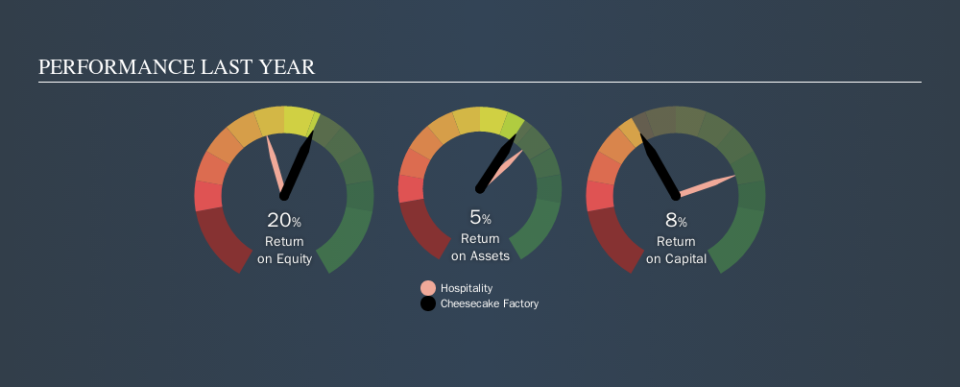Evaluating The Cheesecake Factory Incorporated’s (NASDAQ:CAKE) Investments In Its Business

Today we'll evaluate The Cheesecake Factory Incorporated (NASDAQ:CAKE) to determine whether it could have potential as an investment idea. In particular, we'll consider its Return On Capital Employed (ROCE), as that can give us insight into how profitably the company is able to employ capital in its business.
First of all, we'll work out how to calculate ROCE. Then we'll compare its ROCE to similar companies. Then we'll determine how its current liabilities are affecting its ROCE.
Return On Capital Employed (ROCE): What is it?
ROCE is a measure of a company's yearly pre-tax profit (its return), relative to the capital employed in the business. In general, businesses with a higher ROCE are usually better quality. In brief, it is a useful tool, but it is not without drawbacks. Renowned investment researcher Michael Mauboussin has suggested that a high ROCE can indicate that 'one dollar invested in the company generates value of more than one dollar'.
So, How Do We Calculate ROCE?
Analysts use this formula to calculate return on capital employed:
Return on Capital Employed = Earnings Before Interest and Tax (EBIT) ÷ (Total Assets - Current Liabilities)
Or for Cheesecake Factory:
0.085 = US$138m ÷ (US$2.1b - US$437m) (Based on the trailing twelve months to July 2019.)
So, Cheesecake Factory has an ROCE of 8.5%.
Check out our latest analysis for Cheesecake Factory
Does Cheesecake Factory Have A Good ROCE?
ROCE is commonly used for comparing the performance of similar businesses. Using our data, Cheesecake Factory's ROCE appears to be around the 9.1% average of the Hospitality industry. Separate from how Cheesecake Factory stacks up against its industry, its ROCE in absolute terms is mediocre; relative to the returns on government bonds. Readers may find more attractive investment prospects elsewhere.
We can see that , Cheesecake Factory currently has an ROCE of 8.5%, less than the 21% it reported 3 years ago. This makes us wonder if the business is facing new challenges. You can see in the image below how Cheesecake Factory's ROCE compares to its industry. Click to see more on past growth.
When considering ROCE, bear in mind that it reflects the past and does not necessarily predict the future. ROCE can be misleading for companies in cyclical industries, with returns looking impressive during the boom times, but very weak during the busts. This is because ROCE only looks at one year, instead of considering returns across a whole cycle. What happens in the future is pretty important for investors, so we have prepared a free report on analyst forecasts for Cheesecake Factory.
Cheesecake Factory's Current Liabilities And Their Impact On Its ROCE
Current liabilities include invoices, such as supplier payments, short-term debt, or a tax bill, that need to be paid within 12 months. Due to the way the ROCE equation works, having large bills due in the near term can make it look as though a company has less capital employed, and thus a higher ROCE than usual. To counter this, investors can check if a company has high current liabilities relative to total assets.
Cheesecake Factory has total liabilities of US$437m and total assets of US$2.1b. As a result, its current liabilities are equal to approximately 21% of its total assets. This very reasonable level of current liabilities would not boost the ROCE by much.
The Bottom Line On Cheesecake Factory's ROCE
That said, Cheesecake Factory's ROCE is mediocre, there may be more attractive investments around. Of course, you might find a fantastic investment by looking at a few good candidates. So take a peek at this free list of companies with modest (or no) debt, trading on a P/E below 20.
For those who like to find winning investments this free list of growing companies with recent insider purchasing, could be just the ticket.
We aim to bring you long-term focused research analysis driven by fundamental data. Note that our analysis may not factor in the latest price-sensitive company announcements or qualitative material.
If you spot an error that warrants correction, please contact the editor at editorial-team@simplywallst.com. This article by Simply Wall St is general in nature. It does not constitute a recommendation to buy or sell any stock, and does not take account of your objectives, or your financial situation. Simply Wall St has no position in the stocks mentioned. Thank you for reading.

